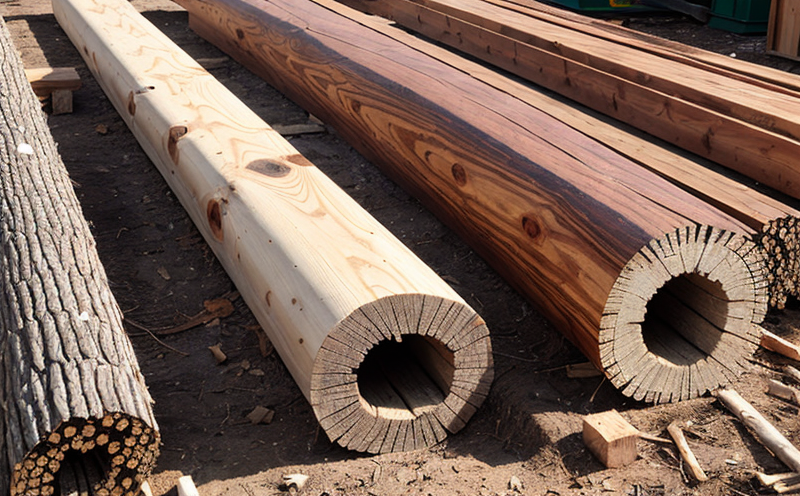Brown Rot Fungi Resistance Testing in Wood
In the realm of agricultural and forestry testing, the durability of wood is a critical factor. Brown rot fungi resistance testing is essential to ensure that structural elements such as poles, posts, and timbers used in construction can withstand fungal degradation over time. This testing ensures not only longevity but also resilience against environmental stresses that can compromise the integrity of wooden structures.
The process involves exposing wood specimens to controlled environments where brown rot fungi are present. The specimens are then assessed for weight loss, physical property changes (such as moisture content and mechanical properties), and visual deterioration. This method provides a comprehensive understanding of how different types of wood react to fungal attack under standardized conditions.
Testing is conducted in accordance with international standards such as ASTM D1414-18, which specifies the procedure for determining resistance to brown rot fungi. Compliance with these standards ensures that the test results are reliable and comparable across industries. R&D engineers often use this data to refine wood preservation techniques or develop new formulations of preservatives.
Quality managers rely on this testing to ensure product consistency and meet regulatory requirements. By understanding the specific resistance levels, they can make informed decisions about which species of wood and treatments are best suited for particular applications. This information is crucial for compliance officers who must adhere to local and international regulations governing the use of treated wood.
The impact of brown rot fungi on wooden structures extends beyond just the material itself; it affects the entire ecosystem. In agricultural settings, for instance, decayed wood can become a breeding ground for pests, leading to further damage. By testing for resistance early in the development process, manufacturers and designers can mitigate these risks.
From an economic perspective, the cost of replacing damaged structures due to fungal attack can be substantial. Testing helps identify the most effective preservation methods, reducing long-term costs while enhancing sustainability by minimizing waste.
In summary, brown rot fungi resistance testing is a vital component of ensuring that wood used in construction and agricultural applications remains robust against degradation. It supports compliance with international standards, aids R&D efforts, and provides valuable data for quality management and regulatory adherence.
Applied Standards
The application of internationally recognized standards is crucial to the accuracy and consistency of brown rot fungi resistance testing. The primary standard used in this testing is ASTM D1414-18, which outlines the procedure for determining resistance to brown rot fungi. This standard ensures that all tests are conducted under controlled conditions, providing a reliable basis for comparison.
- ASTM D1414-18: Procedure for Determining Resistance to Brown Rot Fungi
- EN 352-5:2016: Timber Protection Products - Part 5: Laboratory Tests for the Resistance of Wood and Timber Products Against Decay by Fungi and Insects
These standards provide a framework that ensures uniformity in test procedures, specimen preparation, and evaluation criteria. Compliance with these standards is essential for ensuring that the testing results are valid and can be relied upon for decision-making processes.
The use of these standards also facilitates international trade by providing a common language for quality assurance across different geographical regions. This is particularly important in agricultural and forestry sectors where products may need to meet diverse regulatory requirements.
Why Choose This Test
The decision to conduct brown rot fungi resistance testing is driven by the need for reliable data that can inform product development, quality assurance, and regulatory compliance. Here are several reasons why this test is crucial:
- Enhanced Durability: Ensures that wooden structures last longer in environments prone to fungal attack.
- Regulatory Compliance: Meets the stringent requirements set by international standards, ensuring product reliability and safety.
- Economic Benefits: Reduces costs associated with premature failure of wood products due to decay.
- Sustainability: Contributes to sustainable practices by extending the life cycle of wooden structures.
The data obtained from this testing can be used to improve product formulations, refine preservation methods, and enhance overall quality. These benefits make brown rot fungi resistance testing an indispensable part of the agricultural and forestry sectors.
Customer Impact and Satisfaction
Conducting brown rot fungi resistance testing has a direct impact on customer satisfaction by ensuring that products meet or exceed expectations in terms of durability and quality. Here’s how:
- Increased Product Lifespan: By identifying wood species with high resistance to fungal decay, customers can expect longer-lasting wooden structures.
- Improved Reliability: Compliance with international standards ensures that products are reliable and safe for use in various applications.
- Economic Efficiency: Reducing the need for premature replacements saves time and money for both manufacturers and end-users.
- Sustainable Practices: By promoting sustainable practices, this testing contributes to environmental conservation efforts.
Customer satisfaction is further enhanced by the transparency and reliability of the test results. This ensures that customers can trust the quality of products they purchase, leading to repeat business and positive口碑传播





